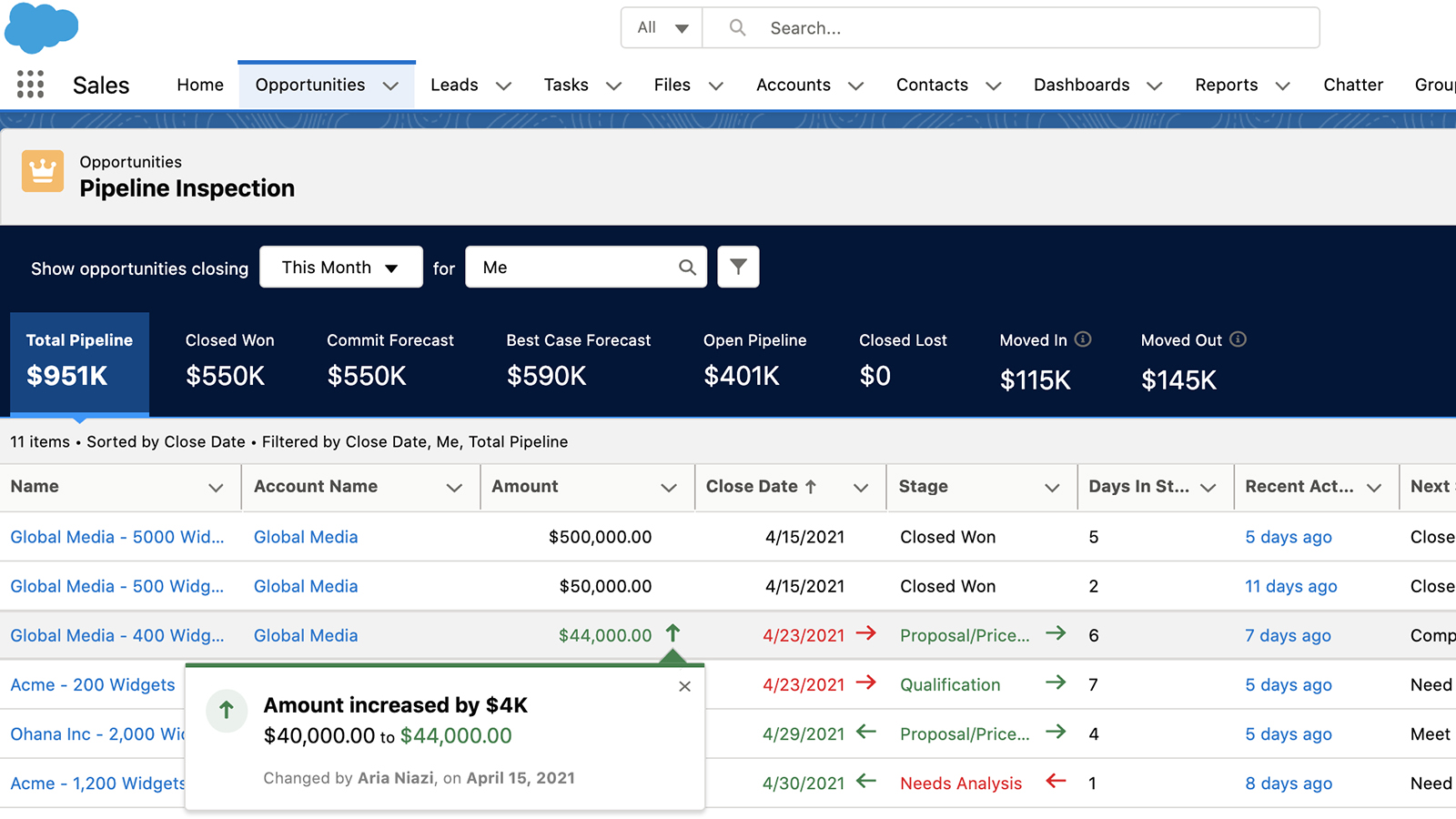Pipeline Reviews are the Worst – Here Are 9 Easy Ways to Fix Them



Pipeline meetings are often excruciating for reps & managers. But they don’t have to be. Here's how to fix common pipeline meeting mistakes.
Salesforce Authors
Self-proclaimed “old school to new school” sales leader Richard Harris remembers the first time someone quit on him. “No resignation letter — she just left.”
The reason? A series of painful pipeline review meetings.
“During reviews, I would ask for X and she would give me Y. She had her own path to closing deals, but I never took the time to understand her process,” said Harris, who now runs the Harris Consulting Group, a sought-after sales training company. “One day, she walked out in frustration.”
While successful pipeline reviews identify ways reps can move deals ahead, they often fall flat. There are countless reasons — poor sales data, misaligned goals, lack of preparation, miscommunication, and poor management skills — but with productive pipeline reviews at the core of accurate business forecasting, it’s critical sales teams get them right.
What is a pipeline review?
Held weekly or twice a month, a pipeline review is a meeting between a sales rep and manager to discuss the status of pending deals. These meetings solely focus on obstacles to closing deals and steps that the rep or the manager can take to remove those obstacles.
Responsibility for successful reviews rests on top-level sales leaders and CROs. These “buck stops here” C-levels need to frame pipeline review structure and cadence so reps and managers are set up for success.
Fortunately, it’s eminently doable. Over the years, I’ve learned several simple methods for making pipeline reviews efficient and useful. Sales leaders: take note.
1. Cancel teamwide pipeline reviews
Group pipeline reviews are almost always a waste of time. Some managers may think this is the perfect way to coach — working through one rep’s stalled deal and using it as a guidepost or lesson for the entire team. The truth is, reps don’t pay attention.
Keep your pipeline reviews between individual reps and the manager. This ensures that both are focused on the deals that matter.
There is one exception: when multiple reps are involved in a sale, managers should bring them together for collaborative strategising and problem-solving.
2. Make pipeline maintenance easy with automation
Dirty data is a pernicious sales problem. Busy reps often fail to update their company’s dated customer relationship management (CRM) platform or do piecemeal data entry. This makes pipeline reviews a mess; managers and reps can’t accurately assess the status of leads when data is incomplete. The solution is a combination of process automation and updated team training.
To assist busy reps, deploy artificial intelligence-enabled CRMs with automated workflows that minimize manual data entry. Sales Cloud, for example, automatically logs all of your calls, emails, and notes so that you don’t have to.
Reps still need to enter some data, however. Be sure you train them to update critical deal information as they receive it. They’ll need reminding, too, so encourage managers to check in regularly about data input.
Lastly, be sure managers and reps work with the same data set in your CRM, regardless of how dashboards are configured. This ensures everyone can see the most critical lead data in the pipeline, even if dashboards are slightly different.
Automate pipeline management with Sales Cloud
Data syncing and AI-powered risk tracking improve sales efficiency for both reps and managers — while minimizing manual pipeline maintenance.

3. Leave out the chitchat
It’s tempting for reps and managers to go off on tangents during pipeline reviews, but this is not the time for idle chitchat or deeper strategy discussions. It’s also not the place for training modules, extended coaching sessions, or company updates. Stick to leads and keep your reviews to no more than 30 minutes.
If managers have information they need to share with reps, they should use email or Slack. Not only does this create a “paper trail,” but reps can review messages when they have time, outside of focused discussion on leads.
4. Split meeting time among the three biggest opportunities
It’s tempting to focus on one problem lead for the entire meeting, but this leaves other leads unaddressed. To avoid this, sales vets like Harris recommend creating a clear agenda:
- 4 minutes: Overview/general status
- 7 minutes: Problem lead #1 review
- 7 minutes: Problem lead #2 review
- 7 minutes: Problem lead #3 review
- 5 minutes: Wrap up and identify action items
To ensure your time isn’t wasted, make sure reps and managers examine the same lead metrics, ideally from the same CRM dashboard.
5. Define exit criteria for each pipeline stage
Muddy pipelines are caused by more than dirty data. In too many cases, reps don’t know when a lead should move from one stage in the pipeline to the next. Naturally, this makes pipeline reviews fuzzy; managers and reps end up with very different ideas about the status of leads at any given moment.
Nip this in the bud by clearly outlining how the rep can complete each stage of the pipeline. In my experience, the best way to approach this is by crafting two to three questions for each stage. The answers should very clearly indicate whether or not a lead is ready to move down the pipeline.
For example, to move a lead from qualification to the demo stage, reps should ask questions like:
- Has the lead articulated a clear use case for the product in his/her company?
- Does the company meet the technical requirements needed to use the product?
- Is this product within the company’s budget?
If the answer to all three of these questions is “yes,” the lead is likely ready for a demo.
Free training: Learn to manage prospects from lead to close in Sales Cloud
6. Identify clear action items and priorities
As noted above, every pipeline review meeting should focus on action items for the week ahead, not what happened the week before. For example: What are the specific obstacles preventing a deal from moving forward? Who will tackle each obstacle — the rep, the manager, or the executive leadership? Which one is most important? These should be clearly defined and aligned with metrics so both managers and reps can measure progress.
7. Create an accountability mechanism for reps and managers
One of the biggest pitfalls of pipeline reviews is the lack of accountability — for both reps and managers. To ensure follow-through on action items, make sure managers connect with reps by phone or email at the end of the week.
Another option is to use a CRM to track progress. This single source of truth gives managers visibility into rep activity, making it easy for them to follow up with critical questions about leads that aren’t moving forward.

8. Avoid the blame game
With searing pressure to close deals and boost revenue, many sales managers ask leading questions in pipeline reviews to get the answers they want. When reps fumble, unsure of how to move a lead closer to a sale, managers pounce. Blame is assigned and reps become frustrated.
This fault-finding game is a waste of time. Managers should frame pipeline reviews differently to avoid this: problems lie with opportunities, not with reps. Instead of lambasting salespeople for not meeting quotas or providing answers that managers want, think of team-oriented solutions. Managers should steer clear of questions like, “How did you get that wrong?” Instead, they should ask, “What can we do to make this work?”
9. Stagger one-on-one check-ins with pipeline reviews
This tip comes from a common misconception (and one of my personal pet peeves): One-on-one manager check-ins are also pipeline reviews. Nope.
Check-ins and pipeline reviews should be scheduled separately and staggered to avoid meeting overload. I recommend having two one-on-one manager check-ins per month and two pipeline reviews per month. As needed, you may fold in more reviews toward the end of the quarter to make sure deals are on track. If that’s the priority, don’t schedule competing one-on-ones. Give reps time to focus on what they do best — sell.
Next steps
Pipeline reviews are the heartbeat of goal-oriented, empowered sales teams. They give reps the tools and insight they need to close deals and allow managers to create accurate forecasts. To ensure they’re successful, keep them actionable and focused. As our own Vice President of Product Marketing Brian Bachofner advises, “Identify the key activities that will move deals ahead. This will increase the health of the pipeline, the accuracy of forecasts, and the likelihood of meeting — or exceeding — quotas.”
Make forecasting easy with the AI insights and analytical power of Sales Cloud
Streamlined data, easy pipeline inspection, and sales conversation insights pave the way for hyper-efficient revenue tracking.






















